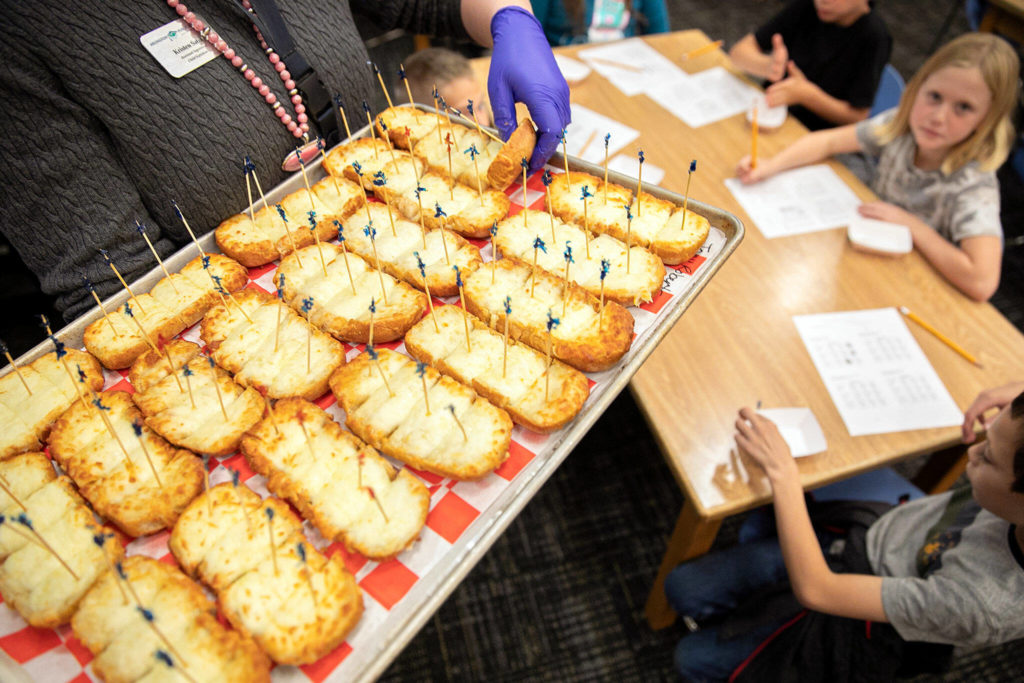ARLINGTON — A garlicky aroma powerful enough to vanquish a vampire wafted out of the Eagle Creek Elementary School library Tuesday.
Inside the room at a table surrounded by their third grade classmates, Tucker Nielsen and Booker Barlow scrutinized slices of pungent toast slathered with butter and cheese.
“We’re taste testing, like, garlic bread pizza,” Tucker explained to a Daily Herald reporter as he and Booker prepared to give their remarks on the taste, texture and appearance. “If we all really like it, they’re going to put it on the lunch menu I think.”
Their school will send their reviews to the state superintendent’s office to help staff decide which U.S. Department of Agriculture suppliers to contract with next year for school lunches.
Booker bit into a slice of bread with an audible crunch. He chewed slowly, then swallowed.
“This one has less garlic,” he announced, like a young Anthony Bourdain, before shading in three “I like it” smiling faces on a rubric fit for 8- and 9-year-old food critics. Then Booker paused and erased the markings in one row.
“Actually, though, I didn’t like the texture,” he said, coloring in a neutral face with the label, “It is OK.”
Arlington will submit more food critiques collected from middle and high school students this week. Student taste tests are key to make sure the food the state buys actually gets eaten, said Leanne Eko, director of child nutrition services for the state agency.
“It really doesn’t matter what us adults at the state agency think about a product,” Eko said. “It depends on what the district and the students think about the product.”
The state distributed nearly $37 million of federally funded food during the 2020-21 school year, and it’s important that money doesn’t go to waste.
“Let’s say we bought cheesy garlic bread ‘X,’ and we didn’t have anybody taste test it … then everybody hates it, so they don’t order any of it after the first month,” Eko said. “We have all this cheesy garlic bread sitting in our freezer, and that doesn’t benefit anyone.”
In Washington, every school lunch must include a meat or meat alternative, a grain, a fruit, a vegetable and milk or a milk alternative. Most of the ingredients used in the food must be grown or sourced in the United States, and other requirements regulate how many whole grains or how much sodium each food group can have.
USDA foods automatically meet those requirements.
The state contracts with USDA suppliers to buy food using federal funding from the National School Lunch Program. The ingredients are brought by the truckload to four Washington warehouses, then distributed to local school districts.
Each district gets an “entitlement,” or a certain dollar value of food they can request. School districts supplement USDA food with other goods they purchase on their own.
Those commercial purchases tend to make up the bulk of a school district’s food, because “the state only has so many dollars they can provide,” said Kristen Satra, assistant director of food services for the Arlington School District. But districts will try to pull from the state first, because it’s a free, easy way to fill in the menu.
“That product is provided to us with grant money, so it’s free of charge to us,” Satra said, noting the food always meets nutrition standards. “… We will use those funds 100% before we go search for other products.”
Signing up to taste test products for the state ensures that contracts meet taste bud standards, too. And it gives the district ideas for what to serve locally, Satra said. Even if the state agency chooses not to stock a particular food, the district can purchase it commercially.
“If the students really like a certain product tremendously more than they like another product, we will absolutely use it,” Satra said. “Our goal is to increase participation and feed as many students as we possibly can. We definitely want to give them something that is tasty, and something they look forward to and are excited about eating.”
Taste tests also help the state make sure the products it stocks work well for staff, Eko said. The samples are prepared on-site at the district, so it’s like a test kitchen for the cooks.
“A district might tell us that … the packaging wasn’t good. It split, and then the items dried out or stuck together,” Eko said.
The state orders food products in waves, so it can adjust orders with its contracted suppliers, as needed. The agency usually signs a one-year contract with an option to renew for up to four years.
The cost of the contract carries the most weight when deciding which supplier to use, Eko said. Past performance of a supplier factors in, to a lesser degree. The kids get some say, too.
On Tuesday, from their seats in the library, the third grade students Booker and Tucker took their jobs as taste testers seriously.
“I feel like I have different taste buds for cheese now,” Tucker said after a thoughtful discussion of how much dairy the perfect slice of garlic bread should have. The answer? Lots.
“Kids, and particularly young kids, are really textural and visual eaters,” said Satra, the assistant director of food services. “So if food looks funny, they may not even give it a chance.”
Some students described their least favorite bread as “watery” and “wet.” But most of the samples earned rave reviews.
“I literally put ‘I love it’ in every single one,” said third grader Emmitt Pettibone, his words doused in a garlic scent.
A Schwan’s brand bread seemed to rise to the top of the list for most students. Booker told the Herald it was “five out of five.”
“The texture is good, and the cheesy taste, and the garlic taste,” he said.
Once they wrapped up the taste test, the students lined up at separate doors to leave for their actual lunch period. A few of the kids waddled into place with their hands on their bellies.
“I’m stuffed,” one said.
Still, the mini food critics all tried to find room in their stomachs for their next meal, nacho day.
Mallory Gruben is a Report for America corps member who writes about education for The Daily Herald.
Mallory Gruben: 425-339-3035; mallory.gruben@heraldnet.com; Twitter: @MalloryGruben.
Talk to us
> Give us your news tips.
> Send us a letter to the editor.
> More Herald contact information.





























